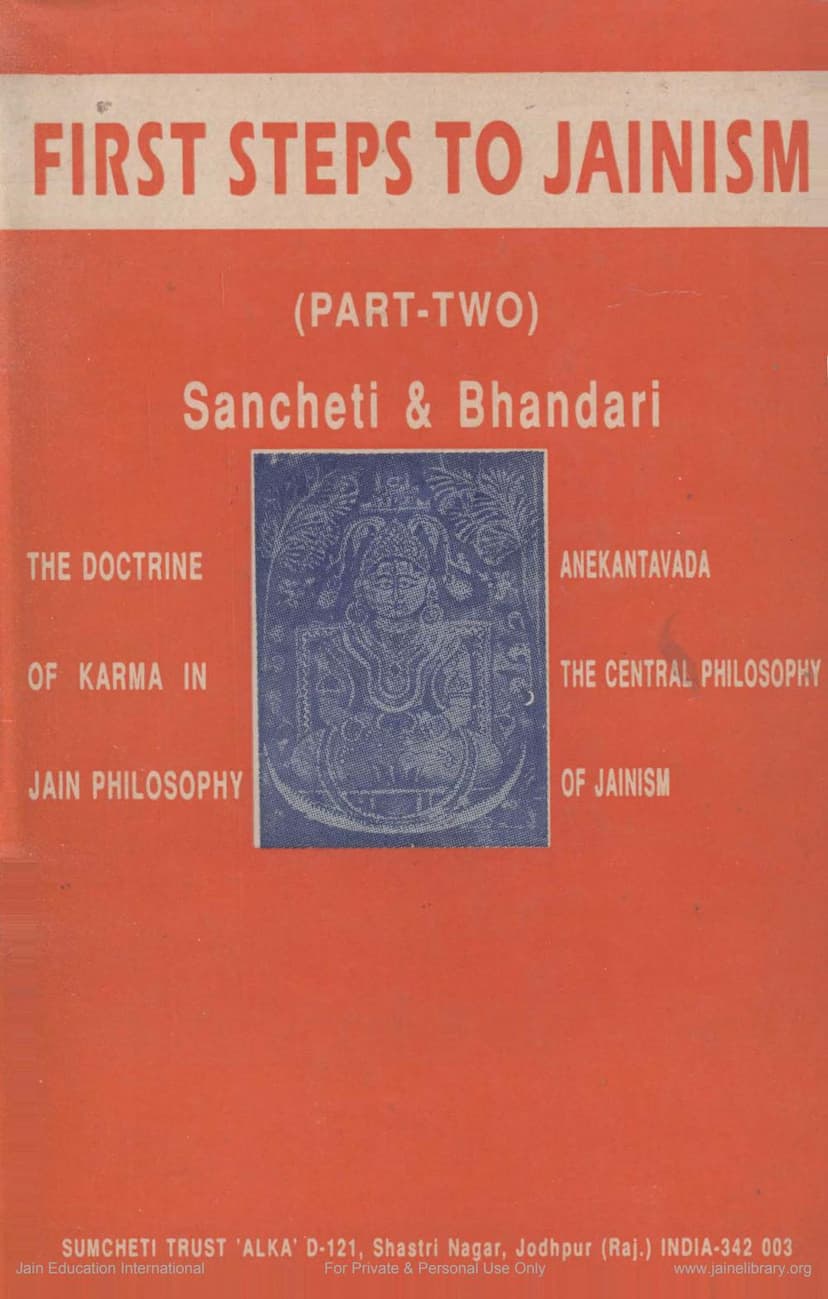First Steps To Jainism Part 2
Added to library: September 1, 2025

Summary
This document is the second part of "First Steps to Jainism," authored by Sancheti Asoo Lal and Manakmal Bhandari, and published by Sancheti Trust Jodhpur. It serves as an introduction to core Jain philosophical concepts, building upon the foundational information provided in Part One.
The book is structured to cover several key areas of Jain philosophy:
- The Doctrine of Karma: This is presented as a central and highly significant doctrine in Jainism. It elaborates on the unique Jain understanding of Karma, emphasizing its concrete, realistic, and physical nature. Karma in Jainism is described as subtle material particles with psychophysical qualities that attach to the soul, determining the course of life. The book delves into the various aspects and types of Karma, drawing heavily on Dr. H.V. Glasenapp's work. It explains how Karma matter enters and binds the soul through "Yoga" (vibrations of the soul) and "Kashaya" (passions like anger, pride, deceit, and greed). The text details the eight main categories of Karma (Gyanavarniya, Darshnavarniya, Vedneeya, Mohaneeya, Aayu, Naam, Gotra, and Antraya) and their numerous sub-divisions, explaining their effects on the soul and its experiences. The concepts of "Karma Bandh" (bondage) and "Nirjara" (shedding of Karma) are explained as crucial for spiritual progress and liberation (Moksha).
- The Fourteen Gunasthanas (Stages of Spiritual Progress): This chapter outlines the soul's journey toward liberation through fourteen stages of spiritual development. These stages are directly influenced by the reduction of the soul's Karma load. The Gunasthanas represent milestones on the path of spiritual purification, moving from ignorance and attachment to omniscience and ultimate liberation. The text describes the characteristics of each stage, the causes for regression or progress, and the role of mental states (Yoga, Kashaya, Pramad, Avirati, Mithyatva) in determining one's position on this spiritual ladder.
- The Five Bodies: Jainism posits that the soul acquires five types of bodies due to its connection with Karma. These are the gross physical body (Audarik), the transformation body (Vaikriya), the translocation body (Aharak), the fiery body (Taijasa), and the Karmic body (Karmana). The book describes the nature and function of each body, emphasizing that these are material constructs that bind the soul. Liberated souls are "Ashariri" (bodiless). The Karmic body is considered the root cause of worldly existence and constantly renews itself.
- Anekantavada (The Central Philosophy of Jainism): This chapter introduces Anekantavada, the doctrine of non-one-sidedness, as a pivotal contribution of Jain thought. It explains that Anekantavada emphasizes the multi-faceted nature of reality and encourages understanding issues from various viewpoints. It's presented as a synthesis of seemingly contradictory ideas, promoting tolerance and reconciliation. The concept is illustrated through the parable of the blind men and the elephant, highlighting how grasping only one aspect of reality leads to incomplete and dogmatic conclusions. The text draws parallels between Anekantavada and modern scientific concepts like complementarity in physics.
- Nayavada (Doctrine of Standpoints): As a practical application of Anekantavada, Nayavada emphasizes viewing reality from different standpoints (Nayas). It explains that comprehending the complete nature of an object requires considering multiple perspectives, much like different pitchers of water contributing to the understanding of the ocean. The book outlines various classifications of Nayas, including Dravyarthik (substance-related) and Paryayarthik (mode-related) Nayas, and the five main categories: Naigam, Sangrah, Vyavahar, Rjusutra, and Shabda.
- Syadvada (Doctrine of Sevenfold Predicates): This doctrine, closely related to Anekantavada and Nayavada, offers a structured way to express conditional truths. It uses the particle "Syat" (meaning "in a certain sense" or "may be") to qualify seven types of predication (Saptabhangi). These predicates address existence, non-existence, both, inexpressibility, and combinations thereof, allowing for a nuanced understanding of reality that avoids absolute assertions. The book suggests parallels between Syadvada and modern statistical probability.
- Freedom of Will (The Five Samvay): This chapter explores the age-old debate about destiny versus human effort. Jain philosophy acknowledges five factors (Samvay) influencing events: Time (Kaal), Nature (Swabhav), Past Karma (Purakrit), Destiny (Niyati), and Human Exertion (Purusharth). While all are considered important, Purusharth (effort) is given primary importance as the active and responsible agent, emphasizing that individuals have the freedom to shape their destiny through their actions.
The book also includes appendices featuring scholarly articles by prominent figures like Dr. D.S. Kothari, Dr. P.C. Mahalanobis, and Dr. J.B.S. Haldane, which further explore the connection between Jain philosophy (particularly Syadvada) and modern scientific concepts. Prefaces by Dr. H.V. Glasenapp and Prof. R. Zimmerman are also included, offering valuable context and appreciation for the depth of Jain thought.
In essence, "First Steps to Jainism Part Two" provides a comprehensive yet accessible overview of the metaphysical and philosophical underpinnings of Jainism, focusing on the intricate doctrine of Karma, the soul's spiritual progression, and the unique logical frameworks of Anekantavada, Nayavada, and Syadvada. It highlights Jainism's emphasis on personal responsibility, ethical conduct, and a nuanced understanding of reality.